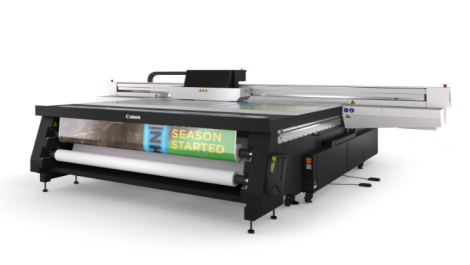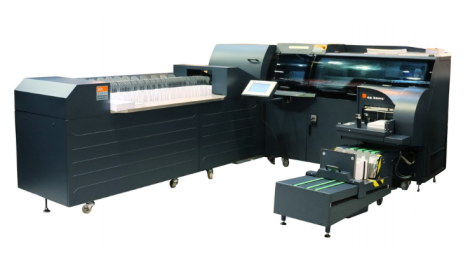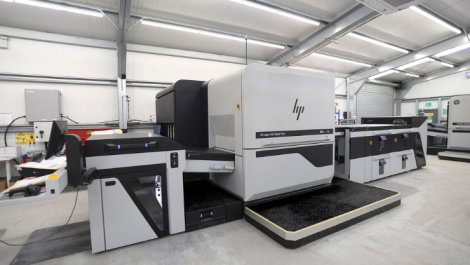Direct mail specialist Howard Hunt Group is running a Kodak Prosper 5000XL full colour inkjet web press in Dartford. Simon Eccles sees it in action.
Last month was particularly satisfying for Howard Hunt. Not only did it win Digital Printer’s Supreme Award, but it started offering the UK’s first Kodak Prosper Press 5000XL web fed inkjet colour press for live jobs.
The company has been running up the Prosper Press for the past eight months and now it’s ready for the next stage. ‘We are speaking with all our clients now with a view to producing some live work on the Prosper as we feel the time is right to put the machine to the test in terms of production,’ says production director Keith Whitehead. The direct mail and data services specialist has long experience of digital printing, with a battery of Scitex (now Kodak) 4.5 inch inkjet heads fitted to Scheffer finishing lines, plus Kodak Versamark inkjets, a couple of Xeikon 8000 web fed toner presses (used for the award winning job), and a Kodak NexPress 2500 sheetfed colour toner press.
The Scitex heads are used to add black-only personalisation to conventional fixed-image colour print from the company’s Mitsubishi and Komori heatset webs. The Versamarks are standalone inkjet presses, but with relatively low quality. What the Prosper Press opens up is the prospect of ‘white paper’ production: fully variable colour print at high speed, with quality that’s said to match offset. It takes webs up to 648 mm wide in 45 to 300 g/m2 weights for 8, 12 or 16 page sections. It runs at 200 metres per minute, equivalent to 3600 A4 pages, with a duty cycle of up to 90 million pages per month.
Howard Hunt was originally founded in 1990 as a City printer on the Old Kent Road in south London. Today it has a £60 million turnover. It moved to its present location in Dartford on the Thames estuary in 1998 and started direct mail operations. ‘We developed this to become experts in the market,’ says Lucy Edwards, deputy managing director at Howard Hunt. ‘It was a good core, but we felt we had to add more services.’
The result was the launch of Celerity Marketing, a data services company within the group that specialises in database work. It is now introducing a company-wide platform called Connector, to can handle all aspects of data, including analysis, segmentation, market automation and channel preferences, with output to the likes of SMS, e-mail, social media and of course printing.
Ms Edwards is excited about the new system’s potential. ‘Prosper is a revelation, a big step change,’ she says. ‘It gives us litho quality and speed, with digital complexity. Put those all together and it is a big step forward. The time out of the door is remarkable. Previously direct mail was largely limited to personalisation of names and addresses. Now we can have 100% variability. Litho has quality and speed, but not response. Prosper has speed, quality, response and variability.’
She says that the combination of Connector with the Prosper’s ‘white paper’ ability speeds up response times enormously: ‘It can be created, printed and out the same day. This way, direct mail is almost as immediate as an online campaign. This is not just time-saving, it allows integrated campaigns. Personalised direct mail can be very effective as it talks directly to the reader. If integrated with online elements it can drive recipients to the web and then to online purchase.
‘It can also work the other way, so on-line response can trigger information capture that can then be used to generate personalised print as a follow up. Connector frees up marketing people to think about campaigns, not messing about with production, file formats etc, as this is now all automated.’
‘We started investigating high speed variable data printing about four years ago,’ says Mr Whitehead. ‘We signed for the Prosper 5000XL a year ago. We already had the two Xeikon 8000s and the NexPress 2500, so it was a natural progression for us into high speed fully variable printing.’ He said that the HP T300 was also considered, but ‘in our opinion the Kodak quality was a lot better.’
The press remains a Beta test unit that’s still owned by Kodak and as we went to press Howard Hunt had not announced whether it will finally purchase the machine. ‘The Beta test will end when both Kodak and Howard Hunt agree that the machine is now fit for purpose in terms of substrates that can be used and the uptime meets the agreed criteria,’ Mr Whitehead says. The list price is about £2.7 million, although a purchase decision would also entail new infrastructure as well as ordering dedicated finishing equipment.
Howard Hunt has three separate production units grouped close to each other in the industrial area south of the Dartford Crossing, adjacent to the M25 motorway. The Prosper Press has been installed in the 51,000 m2 H3 unit, which houses its other main digital print systems and associated finishing. The 23 metre long press is sited in the main factory floor area as shown above, although if the purchase decision goes ahead the company plans to build an air conditioned enclosure around it, with new offices above this. The Xeikon and NexPress units on the same site are in a separate office type environment.
The press was installed on 21 March after several months of planning together with Kodak. A lot of the time since has been taken up by paper tests and profiling, says Mr Whitehead. ‘The time it takes to profile the papers is approximately two to three hours, but once they are done they are stored in the memory and you just need to retrieve them each time which takes a matter of minutes.’
Despite Kodak’s assertion that the Prosper technology and inks were developed to work with standard offset grades, it’s evident that finding suitable papers to work with the water based inks has been a major challenge for Howard Hunt. A number of paper mills have been supplying samples for test runs, then taking the results away to adjust their formulations. The press is now running at full speed on uncoated grades, which are used for a substantial part of the direct mail work: about 40%, Mr Whitehead says, although this varies with market trends and the time of the year. ‘Coated stocks are still a challenge and they do need to be run slower to allow for drying time, but the mills are working extremely hard to get the make up of the substrate correct for high speed ink jet printing.’
The most suitable coated grade found so far is supplied by the Appleton Papers mill in the USA, but at present this has no major warehousing in Europe so supplies have to be shipped across specially, with about a five week delivery time. ‘They are talking to me about consignment stock until the market takes off fully in the UK,’ Mr Whitehead adds.
Last year Kodak said it was developing a unit to apply a primer coating to standard paper stocks as they went into the Prosper Presses. Howard Hunt did not opt for this, says Mr Whitehead. ‘We looked at it, but at the end of the day the mills will produce paper that will run on these presses. They are more technical than us.’
The company uses the Kodak Prinergy workflow to control both offset CTP and digital workflow. It’s now created an ICC colour profile set for the Prosper. Achieving the best balance between ink weights, press speed and drying is important. ‘This is a learning process for all involved and we have now had more tuition on the colour management side of the equipment,’ Mr Whitehead explains. ‘We now are confident of matching any product to Fogra 29 or 39 standards, depending if the product is coated or uncoated. The key to the colour is to ensure the correct weight goes down and this is controlled through our repro department using Prinergy and our GMC PrintNet T software.’
Kodak’s Stream continuous flow heads, developed for the Prosper family, were designed for high reliability and uptime. There are six heads per colour across the print width, with overlapping areas to ensure seamless coverage. This adds up to 48 heads in the CMYK duplex 5000XL. At Ipex last year Kodak staffers were hinting that head life wasn’t as good as anticipated. However the year since has seen improvements and this doesn’t seem to be a major issue. ‘We haven’t run enough to be able to say for sure yet,’ Mr Whitehead says. ‘Some heads have not been changed at all, but some have been changed a few times.’
Print quality, and thus head performance, is monitored by scanners and cameras at the end of the press. If a nozzle fails in an overlap zone there is some redundancy, so the system can automatically compensate by increasing ink flow through neighbouring nozzles. If it’s outside an overlap there’s likely to be a visible white stripe in the print, necessitating a cleaning routine. If that doesn’t solve it, the head will have to be swapped out. Spare heads are always held in reserve, with the failed units being sent back to Kodak on exchange.
Head changes take about five minutes. For this you open the appropriate cover on the press, then open a door on the print unit itself. The duff head is unclipped and a new one clicked into place.
HP uses fairly conventional thermal heads on its rival inkjet web presses. They are derived from its office printers, so they don’t cost a lot and it can use a lot of them to provide redundancy. A four colour duplex T300 with a 762 mm web uses 70 heads.
Until the purchase decision is made, Howard Hunt hasn’t been able to commit to orders for dedicated finishing kit. At present the press has Hunkeler unwind and rewind units so the printed reels are finished elsewhere in the factory. Mr Whitehead expects that most work will run on 500 mm reels, which can be finished on existing Ehret lines, adding: ‘If I get a format that requires a 647 mm reel, I will run it through our Scheffer offline finishing machines which produce our special product offerings and can also produce mailers or simple folded products.’
To Howard Hunt this is an important project. However, to Kodak, it’s even more vital that the first UK colour Prosper be seen to succeed. Its share price has plummeted this year after a run of loss-making quarters. This is largely blamed on losing its consumer imaging markets, although in July the CEO Antonio Perez blamed poor results partly on ‘start-up costs associated with the commercialisation and placement of Prosper printing systems,’ adding: ‘They have applications with very different substrates and media that we didn’t know they were going to use. That created this complex installation process.’
While the Prosper S-series heads and the monochrome 1000 Press seem to be selling well, only about seven 5000XL installations have been publicly announced. Howard Hunt’s is only the second in Europe, the other being at Servinform Group in Spain. Rotomail in Italy was due to take the first European Beta, but cancelled it in favour of an HP T300 last year. There have been four announced sales in the USA and one in South Korea.
Kodak claims to have sold more than this, but to companies that don’t want to be identified. European marketing director Erwin Busselot says that the only constraint on sales is how fast it can make the 5000XL units.
As we covered in Digital Printer May, Lettershop in Leeds has developed its own ‘white paper’ full colour direct mail line based on Prosper S10 heads rather than a 5000XL. Anton Group in Essex has just ordered Prosper S5 heads for monochrome personalisation of direct mail printed by sheetfed offset. Managing director Paul Murphy says he’s potentially interested in a 5000XL later on: ‘at present we’re waiting to see how our friends down the road get on with theirs!’
Prosper 5000XL Press vital statistics
Speed: up to 200 metres per minute Quality: 175 lpi equivalent Max web width: 648 mm Substrates: 45 to 300 g/m2 uncoated and matt coated Dimensions: 22.9 x 7.6 x 2.6 metres Price: approximately £2.7 million
Contacts: www.graphics.kodak.com





